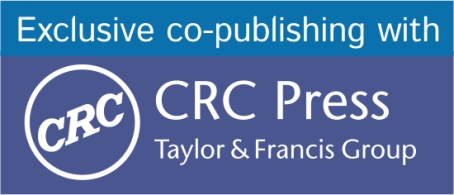|
|
INDIVIDUAL VOLUMES NOW AVAILABLE IN PAPERBACK CONTENTS: About the Authors / Editors: Editors: LinShu Liu, PhD Research Chemist, Eastern Regional Research Center, Agricultural Research Service, US Department of Agriculture LinShu Liu, PhD, is a Research Chemist of the Eastern Regional Research Center, Agricultural Research Service, US Department of Agriculture. He obtained his PhD from Kyoto University, Japan, in 1990, and he was a Postdoctoral Associate at MIT (Massachusetts Institute of Technology), Cambridge, Massachusetts, USA, from 1990–1992. His research interests fall in the areas of delivery systems from naturally occurring polymers for the controlled release of bioactive substances, functional composites from biomass or biobased materials, smart packaging technology and material, and biomedical devices for tissue regeneration, pharmaceutical, and cosmetic applications. Antonio Ballada, PhD Executive Vice President, FasTech SrL; Member of the Board of China Catalyst Ltd., Hong Kong; Consultant Antonio Ballada, PhD, received degrees in industrial chemistry from Milano University and in business administration from Bocconi University, both in Milano, Italy. He has held many top positions in the chemical and pharmaceutical business in Italy, USA, Taiwan, and China. He was CEO of Antibioticos SpA, and he was also responsible for the Catalyst and Additives Business Division at Basell, Inc., where he developed important relationships with the academic world involved in related R&D. He is Executive Vice President of FasTech SrL technology company, active in the elastomers and plastics industries. He is a member of the board of China Catalyst Ltd in Hong Kong and a member of the board of the Consultants Professional Association (APCO). Walter W. Focke, PhD Professor, Department of Chemical Engineering, and Director, Institute of Applied Materials, Pretoria University, South Africa Professor Walter W. Focke obtained bachelor and master’s degrees in chemical engineering at the University of Pretoria and a PhD in polymer science and engineering from the Massachusetts Institute of Technology (MIT), Cambridge, Massachusetts, USA. He is a full professor in the Department of Chemical Engineering and Director of the Institute of Applied Materials at University pf Pretoria in South Africa. He teaches materials science and engineering as well as phase equilibrium thermodynamics at the undergraduate level and polymer processing and polymer additive technology at the postgraduate level. Professor Focke is a registered professional engineer, a member of the American Chemical Society, the Polymer Processing Society, the International Pyrotechnics Society, and the South African Institute of Chemical Engineers. His research is focused on chemical product design with emphasis on carbon materials, polymer additive technology, pyrotechnics, and prophylactic malaria control. Various thermal analysis techniques are employed to characterize and control oxidative processes in pyrotechnics, biodiesel and materials such as polymers and graphite. Professor Focke has published more than 90 papers in peer-reviewed journals. His current Scopus h-Index is 8, and his publications listed in Scopus have been cited more than 1200 times. He is a member of the editorial boards of the Journal of Vinyl and Additive Technology, the International Journal of Adhesion & Adhesives, and International Polymer Processing. Hans-Joachim Radusch, PhD Professor of Polymer Engineering, Center of Engineering Science, Martin Luther University, Halle-Saale, Germany Professor Hans-Joachim Radusch is a full professor of polymer engineering at the Center of Engineering Science at Martin Luther University, Halle-Saale, Germany. He is a world-renown scientist in the field of chemistry, physics and mechanic of polymers , polymer blends, polymer composites, and nanocomposites. He published several books and 500 original papers and reviews in above fields of science. Reviewers and advisory board members: A. K. Haghi, PhD, and Gennady E. Zaikov, DSc |

 Follow us for the latest from Apple Academic Press:
Follow us for the latest from Apple Academic Press:
AAP WELCOMES PROF. MOHAMMED KUDDUS, PhD, AS AAP’S NEW ACQUISITIONS EDITOR for books on biotechnology, enzymology, microbiology, bioinformatics, bioremediation, biomedical technology, value-added products etc. Dr. Kuddus is Head of the Department of Biochemistry at the College of Medicine, University of Hail, Kingdom of Saudi Arabia. He is listed in Elsevier/Stanford University World’s Top 2% Scientists. He seeks book proposals from potential editors to consider for publication with Apple Academic Press. Contact: kuddus@appleacademicpress.com for more information.
AAP welcomes Dr. Maulin P. Shah as AAP’s new acquisitions editor for books on Applied Microbiology, Environmental Biotechnology and Waste Management. Dr. Shah, a Scientist in the Industrial Wastewater Research Lab at Enviro Technology Ltd., India. seeks book proposals to consider for these topics and related areas: applied microbiology, environmental biotechnology and waste management, including environmental pollution, wastewater treatment, bioenergy, biofuel, circular economy, leachate treatment activated sludge process, environmental microbiology, agricultural microbiology, advance oxidation process, bio-electrochemical systems, bacterial genomics for wastewater treatment, and heavy metal remediation. maulinshah1979@gmail.com for more information. AAP is pleased to announce Shrikaant Kulkarni, PhD, as our new Senior Commissioning Editor for books in the areas of Polymer Sciences, Chemical Sciences, Nuclear Sciences, and Material Sciences. Dr. Kulkarni is Adjunct Professor, Faculty of Business, Victorian Institute of Technology, Melbourne, Australia; and Adjunct Professor, Centre of Research Outcome and Impact, Chitkara University, Punjab, India. You can reach him at Email: srkulkarni21@gmail.com for more information. New Book Series: AAP Series on Waste Biomass Valorization will explore the transformation of biomass resources into valuable products, addressing the growing need for sustainable alternatives to fossil fuels and non-renewable resources. For more information and to propose a book, please visit: Click here Congratulations to Hafiz Ansar Rasul Suleria, PhD, for receiving the Dean’s Award for Excellence in Research from the University of Melbourne, Australia, in recognition for his exceptional performance and strong commitment to advanced research in food science. Dr. Suleria is editor of AAP’s book series Innovations in Plant Science for Better Health: From Soil to Fork. For more information, visit: Click here Congratulations to Dr. Christian Mancas. His book Conceptual Data Modeling and Database Design: A Fully Algorithmic Approach was one of the 6 Best Data Modeling ebooks for Beginners by BookAuthority, a leading site for book recommendations. For more information, visit: Click here COMMENTS FROM AAP EDITORS AND AUTHORS AAP book title: Advances in Audiology and Hearing Science (2-volume set) “I have collaborated with AAP during the process of bringing my two-volume editing work to a final publishing phase. AAP support has been truly important throughout the initial and final stages of the book. While the majority of the publishing work is done at the early stages, the final touches that include the last-minute corrections of the authors are extremely crucial to the quality the book tries to convey. The assistance of AAP during the last stages of corrections and communication with the authors was a very positive contributor to my state of mind during those stressful moments. I recommend the publishing experience with AAP to other editors of scientific material.” —Stavros Hatzopoulos, PhD, Hearing Science Laboratory, University Hospital of Ferrara, Ferrara, Italy AAP book title: Nanotechnologies: The Physics of Nanomaterials (2-volume set) “I was very pleased with the interaction and support of the team at Apple Academic Press. They provided me with regular and useful information and updates throughout the publishing procedure. I am also very happy with the final product, which is of good quality. The books are now available and are professionally distributed through the various channels. I would like again to thank the team at AAP for all their hard work and support.” —David Schmool, PhD, Director, Groupe d’Etude de la Matière Condensée GEMaC, National Centre for Scientific Research, Université de Versailles/Saint-Quentin, Université Paris-Saclay,Versailles, France AAP book title: Physiology of Molluscs (2-volume set) “I have enjoyed the full benefit of support, encouragement, and kindness from the members of AAP I have had the pleasure of being associated with. In the same vein, I hope AAP was satisfied with the book series I have edited in advancing the knowledge. It has been a great journey and was a great pleasure and satisfaction. Advancing scholarship through publications is one of the best routes publishers can take, and I would hold AAP as one of the best ones.” —Saber Saleuddin, PhD, University Professor Emeritus, Department of Biology, York University in Toronto, Ontario, Canada AAP book title: Green Chemistry and Sustainable Technology: Biological, Pharmaceutical, and Macromolecular Systems “It had been my pleasure to work with the production team of Apple Academic Press for almost a decade. The best presentation of our work was due to their hard work and with careful scrutiny. I am sure that every one of them takes extra pains to publish the book nicely, maintaining the quality and timeliness. It was a rewarding experience to work with AAP. I would like to publish more with AAP on my upcoming projects in future also.” —Prof. Suresh C. Ameta, Professor of Eminence (Distinguished Professor), Faculty of Science, PAHER University, UDAIPUR, India AAP book title: New Frontiers in Nanochemistry, 3-volume set, plus many others "Publishing a book, either as author or editor, is a journey from the initial vibration to the piece of knowledge towards the present future of humanity at large. Such a journey is about climbing and tunneling, about diving and driving through, about inspiration and tuning, about hard working in every instance; and it is also about time. Very few Global Publishers have the wisdom and patience and kindness and openness to authors, contributors, and readers while being truly crafting oriented as Apple Academic; yet all is about people and their education, vision and assumed mission; the Apple Academic Team heartily succeed that in achieving the world class scholarly acclaim by the quality involvement in all chain of plus value added with each publishing event. Hearty Compliments! Excelsior Apple Academic!" —Mihai V. Putz, PhD, Dr.-Habil., MBA, Professor, Faculty of Chemistry, Biology, Geography, Laboratory of Computational and Structural Physical Chemistry for Nanosciences and QSAR, West University of Timi?oara; PI-1, Laboratory of Renewable Energies - Photovoltaics, National Research and Development Institute for Electrochemistry and Condensed Matter (INCEM), Timi?oara, Romania AAP book title: The Chemical Century: Molecular Manipulation and Its Impact on the 20th Century “All my experiences with AAP have been very positive. I entrusted AAP with the publication of The Chemical Century: Molecular Manipulation and Its Impact on the 20th Century and found the quality of the book that they produced to be excellent. My two contacts at the company were very responsive and efficient throughout the publication process.” —Richard J. Sundberg, PhD, Professor of Chemistry, University of Virginia, Charlottesville, Virginia, USA AAP book titles: Medical Tourism and Wellness: Hospitality Bridging Healthcare (H2H)© and Medical Travel Brand Management: Success Strategies for Hospitality Bridging Healthcare (H2H) “I have enjoyed my scholarly creative work with Apple Academic Press. They have been timely, creative, and very helpful for my two books with them. I encourage you to consider publishing your work with AAP.” —Frederick DeMicco, PhD, RDN, Executive Director and Professor School of Hotel and Restaurant Management, Northern Arizona University, Flagstaff, Arizona AAP book title: The Chemical Evolution of Phosphorus: An Interdisciplinary Approach to Astrobiology “I’m very pleased with the books you have edited. It shows a very good and careful work by everyone involved along the whole production process, and so the final result is a beautiful piece: it has come out as a very nice and appealing book, easy to handle and read, .... and hopefully of interest for people from diverse related fields!” —Enrique Macia-Barber, PhD, Professor of Condensed Matter Physics, Universidad Complutense de Madrid, Spain |



